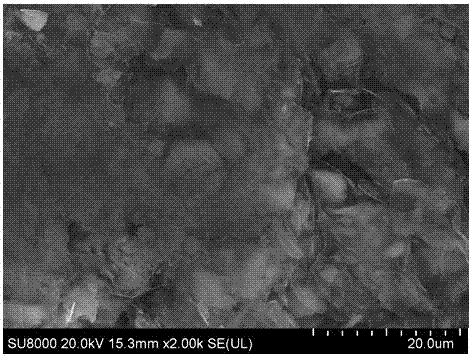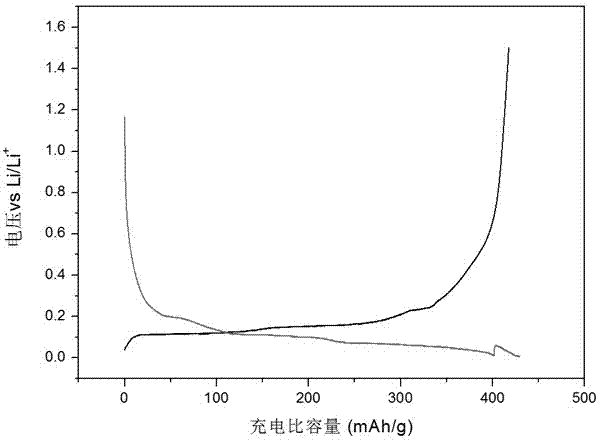Preparation method of silicon carbon negative electrode material for lithium ion batteries
A lithium-ion battery and negative electrode material technology, which is applied in electrode manufacturing, battery electrodes, electrode heat treatment, etc., can solve the problems that it is difficult to insert silicon powder into the gap of expanded graphite, increase material costs, and increase material costs, so as to reduce material costs, Achieving cost and improving flexibility
- Summary
- Abstract
- Description
- Claims
- Application Information
AI Technical Summary
Problems solved by technology
Method used
Image
Examples
Embodiment 1
[0020] 500 g of dimethylformamide was added to 12 g of expanded graphite, ultrasonically treated for 40 min, and 214.3 g of tetraethyl orthosilicate was added to the expanded graphite suspension. Prepare 5% nitric acid aqueous solution, take 17 g of nitric acid aqueous solution and add to the above suspension to prepare the precursor suspension. 285.7 g of deionized water was slowly added dropwise to the precursor suspension and vigorously stirred. After standing for 1 hour, the suspension was dried at 80 °C to obtain the precursor. The precursor was fully mixed with 70g Mg powder, placed in an atmosphere furnace, and heated to 700 °C for 3 hours under an argon atmosphere. The reaction product is washed with acid and then water to obtain a silicon-rich material. 10 g of silicon-rich material and 90 g of natural graphite material were mixed and ball-milled to obtain a silicon-carbon anode material. Its specific capacity can reach 372 mAh / g, and its cycle performance can reach ...
Embodiment 2
[0022] Add 150 g of dimethylacetamide to 3 g of expanded graphite, ultrasonically treat for 30 min, and add 60 g of tetraethylorthosilicate to the expanded graphite suspension. A 10% ammonia solution was prepared, and 33 g of the ammonia solution was added to the above suspension to prepare a precursor suspension. 85.7 g of deionized water was slowly added dropwise to the precursor suspension, and vigorously stirred. After standing for 4 hours, the suspension was dried at 80° C. to obtain the precursor. The precursor was fully mixed with 30 g of Mg powder, placed in an atmosphere furnace, and heated to 750 °C for 2.5 hours under an argon atmosphere. The reaction product is washed with acid and then water to obtain a silicon-rich material. 10g of silicon-rich material and 90g of artificial graphite material were mixed and ball-milled to obtain a silicon-carbon anode material with a specific capacity of 431mAh / g and good cycle performance.
PUM
 Login to View More
Login to View More Abstract
Description
Claims
Application Information
 Login to View More
Login to View More - R&D
- Intellectual Property
- Life Sciences
- Materials
- Tech Scout
- Unparalleled Data Quality
- Higher Quality Content
- 60% Fewer Hallucinations
Browse by: Latest US Patents, China's latest patents, Technical Efficacy Thesaurus, Application Domain, Technology Topic, Popular Technical Reports.
© 2025 PatSnap. All rights reserved.Legal|Privacy policy|Modern Slavery Act Transparency Statement|Sitemap|About US| Contact US: help@patsnap.com


